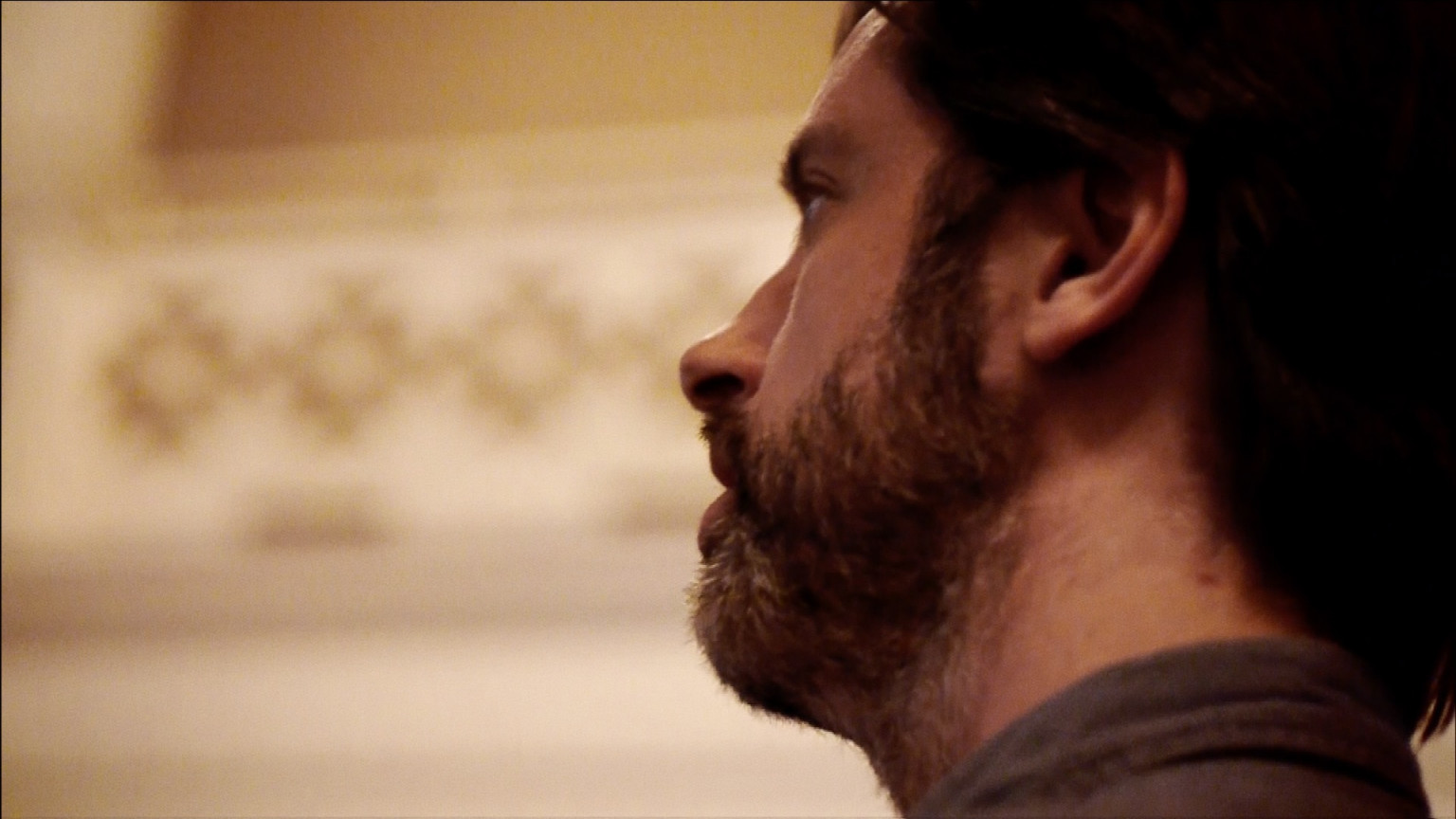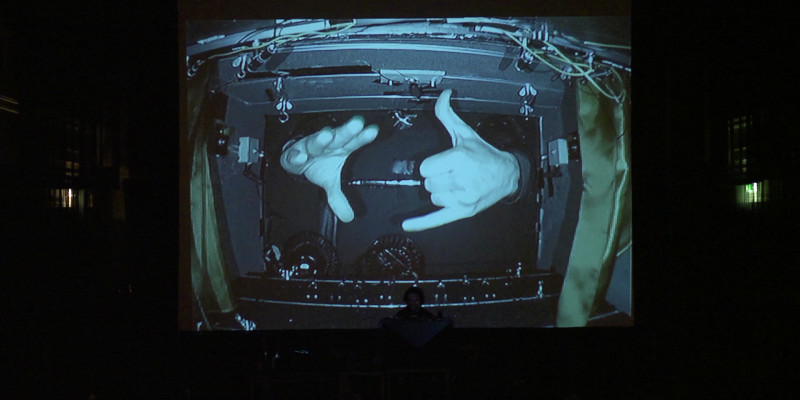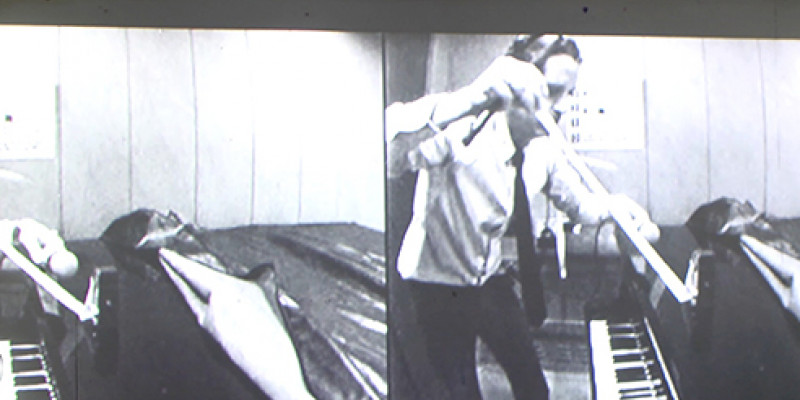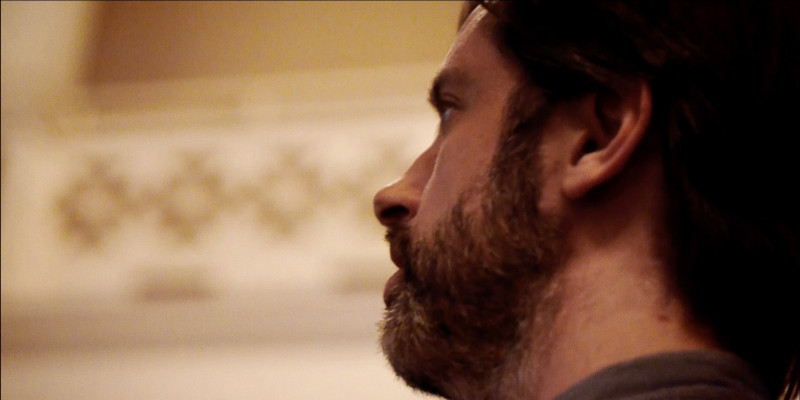
I am a composer
I meet Simon at a coffee bar in Kastrup Airport sometime in August. Simon can only squeeze an hour in with me before he has to rush off again. He has just been in Darmstadt, teaching the summer course and then he had rehearsals in Århus, and now he is on his way to London, for a performance of Black Box Music the following day.
Simon is one of the most performed Danish composers at the moment and he is often present when his music is performed. So he really travels a lot. He lives in Berlin and has done so for almost five years, because as he says: when the whole of Europe is your workplace it is good to live somewhere central. But, there are also other reasons.
Germany
RH: You have told me that Berlin works as the hub of the new music scene, as everything passes through there and that is why, from a career perspective, it is a natural place for you to live. Besides the practical aspects, what has Berlin to offer?
SSA: When I chose to live in Berlin and not on a southern Greek island, it was partly because the city suits my temperament better. Berlin is a cultural centre, characterised by a European mindset, a huge cultural history and a sense of cultural obligation. It is also very convenient that it is not further away from Denmark. It only takes 40 minutes to fly to a meeting in Copenhagen, so it can also be seen as an extension of my workplace, which still includes Denmark. So it is not so much a case of leaving Denmark, it is more that I have moved out into a new territory where I have access to so much more.
RH: When you mention Germany’s huge cultural history, it touches on one of the things I like in your music – that history is always present in your music while at the same time it has an immediate or easy to understand appeal. And that one is not necessarily at the expense of the other. How do you work with these elements?
SSA: In Germany especially, I often encounter interpretations of some of the current Nordic positions, including my own, as an informal and anti-authoritarian way of dealing with historical baggage. And I don’t actually think that is completely wrong. Compared to a German context, us Danes, including myself, take things a bit more lightly.
And on the one hand, I feel a close connection to some of the virtues that are relatively unique to Germany compared to the other European nations. In Germany, criticism and debate are very present and they are usually conducted on a fairly hardcore polemical level, with often sharply defined arguments. All of which can be directly traced back to the aftermath of World War II. No matter how terrible that was, I have to say that on some levels, Germany is one of the last decent countries left. At least, in relation to the self-criticism and institutional criticism that is exercised and how seriously it is manifested. And I feel a connection and a commitment to all of that.
Another part of me is 100% Danish and cannot take it seriously when someone says that things should be done in a certain way or when there are things you are not allowed to do in art. Then I kind of stand in the corner and smile a bit. I can be deeply fascinated by it, but it is not something that works for me. However, I am not saying that I do not relate to a context. I feel that I do, but I use references more freely, with humour and in a slightly more informal tone. And there are also some Germans who work in this way too so you cannot make generalizations when it comes to nationality at all.
In relation to the historical reference, I am aware of it on many different levels. If you want to create something that has a fresh feeling then it is necessary that you are familiar with the historical aspects. And here, above all, it is about not choosing things that are too dusty. Often, it is more a case of excluding things than it is a selection process.
And so I will say, that references back in history are in reality a bit of a new craze for me. I was not that interested in it in the past, but now often I work with very clear references to something historical as I work with references to something familiar in another way. In a way, you can say that the historical elements in my work are just another kind of reference to everyday phenomena.
Music’s potential (part I)
RH: Yes. It is clear that there are all these references, but to me, they are simply just there. They are lined up side by side and they do something to each other, but there is no solution or position taken.
SSA: No, there isn’t.
RH: In the German context we talked about, this could also be a point for criticism - that no position is taken, and that people will think that it is too lightweight. Is dogmatism one of the fusty things you do not opt for?
SSA: Yes, in the actual meaning of the word dogma, as in dogmatic. But I am absolutely crazy about limitations, though mostly in relation to my working process, and they do not really interest me in relation to unwritten or common rules. As a composition method, it is ’prima’, but they aren’t very useful to me as a general rule, where you feel that you are being forced in a certain direction.
RH: Regarding this, we can discuss how you perceive music’s interaction with elements that are not music and elements that are not found within music history, I mean the interaction with the outside world. Do you think music can have critical potential outside such dogmatism – in general and specifically in your own practice, as one which stretches beyond the musical?
SSA: Yes, I do.
Now that is a big discussion. On the one hand, I would argue that there is no such thing as pure music, so to say – or pure art. I would almost go so far as to say that there is no such thing as pure expression in the public sphere. Everything points in one or direction or the other, and even if you do something that really tries not to point in any direction, it is still also a position. So there will always be some kind of statement. And when we realize that the political can be found everywhere, it is just not so interesting anymore – it has pretty much cancelled itself out.
And then of course there is a more explicit level. I am working on a music theatre piece of sorts at the moment (the chamber opera Buenos Aires, editors note), which is about censorship and the dialectics of internal and external obstacles. And on the one hand, I present some things that are obvious dilemmas and clear topics of political discussion. And on the other hand, these themes have become explicit in the opera because they have always interested me in the music as such, and in musical practice and instrumental work. It was not fundamentally meant to be a political statement, but more like a compositional and musical preference through which I have discovered a special kind of energy, intimacy and intensity.
But I would actually say that the greatest potential lies in something that is very ordinary – and thus not very explicitly political. In general, I believe that the very act of working with an alternative to the commercial and the mainstream is important and makes a difference. Having been able to make some noise music, which is relatively radical, from one point of view and at the same time has a direct and relatively broad appeal, then, I think it has a potential that goes beyond the music.
More specifically, I would say that every time you succeed in turning something familiar upside down or in presenting something in a new light, you have achieved a little perceptual or cognitive victory that might even have a potential that stretches understanding beyond the actual artwork itself.
Polyphony of meaning
RH: So is it about how you hope to reach or touch an audience rather than what you want to say to them?
SSA: It is so many things at once. I don’t do anything just because I have a program. But for me, the most thrilling surprise is when you encounter an object and think that you know how it should be and then all of a sudden it is upside down. Or you see something that is upside down and have no idea what it is. Then suddenly you find out that it is a new side of an object you knew already.
The principle is that there is a special element of surprise, which puts a particular material in a new light. My body releases endorphins and something happens to my consciousness, which can become a lasting impression, and these two things are inextricably linked for me. When I go and see a work of art, the best case scenario is that I look at the world a little bit differently when I walk out again.
I cannot separate it. The personal, professional and political levels are all inextricably linked together and it is my preferences in all three of them together that makes me think that something is exciting. When you perceive things that belong to a number of different categories all at once, and thereby create a polyphony of meaning and motivation, it is not so much about being the one or the other, but rather that things might exist concurrently.
Performance and precision
RH: You touch on something that I think is one of the most important aspects of your music. Polyphony of meaning, as you say, is probably quite adequate. If we take a look at Black Box Music for example, it often looks very simple, like there are some things that are a bit random. But when you read the score, you can see that everything that can go wrong has been taken carefully into consideration and very little, if anything, is left to chance.
There are many ‘levels of entry’ in the music but it is also very precise. On the one hand, there is emphasis on the performative elements and on the other hand, there is a clear and rigorous compositional control. Many practices that prioritize the performative, have completely written off this control in favour of giving the musicians more freedom. How do you work with the performance situation, while maintaining the importance of such precision?
SSA: I am a big fan of musical timing and I try and take this with me when I expand the realm of music. In many ways, the first movement of Black Box Music is almost a study of all the things you cannot improvise, namely synchronicity, very sharp clips and a really strictly controlled formal direction. Or indeed, many different directions in the form that are present at the same time.
Above all, and the reason why timing is particularly important in the first movement is because the main element of the experience does not lie in the visual or in the sound but in the connection between the two.
The starting point is an exercise in the way we connect what we hear with what we see, in our heads. It also plays on how we build up some kind of logic in these connections that can be broken up at a later point.
In relation to the form, one could say that it comprises a limited number of scenes and sharp cuts between these. You could also call it different kinds of music or materials that are edited together and each material or scene always continues where just left off. It is just like in the movies when you get the feeling that the scenes take place simultaneously even though we first see a bit of the one and then a bit of the other and in my opinion that causes a formal polyphony or macro-polyphony to occur. I call it ‘pseudo-skinpolyphonic’ form.
Despite the fact that everything is actually monophonic, the many cuts give the feeling that there are different layers that exist side by side and which also develop in each its own direction. Each material or scene culminates at a particular time and each one has their own little cadenza or solo – before making space for the others.
There are no wildly complicated calculations or abstract structures, it is all very concrete: things appear more frequently and they become longer and longer with the different materials constantly evolving. At the same time different kinds of logics are established, with the main purpose to be broken up again later on. In order to have all of these things in play at the same time, and in order to control the timing, it is necessary to notate the process very precisely.
Composer and director
RH: As I see it, precision also plays a role in relation to the performance situation. You are often present when your music is played and you also often play in your pieces too. Does this have something to do with how you see your role as composer in relation to your compositions? Is it two separate things or is it the same thing?
SSA: It is an extension of the composer role in any case.
RH: Yes, you could very well just choose to say that it was finished when you had written it, but you don’t do that very often.
SSA: I don’t think there are so many other ways of doing it when you expand music into the performative. You start by creating a concept and you have a vision, but later on you step into a director’s role in order to realise it. In order to get the best results, things often require different solutions that relate to the people who perform the piece, their temperament, their physique, their instruments and also the space and the context it is performed in.
Being present
RH: Does this mean that you need to be present in order to maintain the authorial precision that you desire?
SSA: Yes, I think so – and also because the vision still comes from me.
You can achieve a lot with really good quality video documentation, but when it comes to the score, and no matter how much I notate, it is often the case that my presence facilitates a better understanding of my ideas. I still haven’t found a solution that can replace my role as a director. Of course there are many unknowns in a theatre script and maybe music is more the same each time, but still one would rather not replace the director of a theatre piece with a video manual.
I have always felt that when I was present, I could communicate, engage, explain and work something out that was better than if I had not been there. When I do the sound engineering or diffusion or control the electronics, then I know exactly what to listen for or what kind of balance I am going for. I could possibly train someone else to do it, but basically I am the only one, because there are so many complicated elements making it difficult to identify precise formulas for how it should be done.
Expanding the realm of music
RH: You are working on an opera (Buenos Aires, editors note) at the moment, and as I understand it, it is a process where you, in the actual composition process, engage even more with the musicians than you usually would. How does this differ from the way you usually work?
SSA: I would say that it is the same process, but one step further and with an even greater element of expansion. But to an extent, it is exactly the same project that aims to expand the realm of music. Note that I have used the same word throughout, expand the musical material and expand the music into something else. Instead of talking about combining, letting different things meet, or wholly leaving music behind as a sort of ’composition beyond music’, the essence of my project is to keep both feet firmly rooted in the middle of the music.
And even though I take on different roles, make videos, stage different things or concern myself with movement sequences, I am still a composer. I am not going to suddenly become a film director or a video artist. I am a composer.
I have expanded my material, but it is the same mindset, the same preferences, the same aesthetics. For me, it is about integrating the different elements, not so they are just layers on top of each other but in a way where they are truly integrated, so you do not have the meeting of two elements from two different worlds, but instead you have one element that belongs in both worlds.
If that is the ideal, then it is logical that you cannot start with an idea that is music, and then later on get an idea about how it should be staged and even later in the process, a third idea that for example has something to do with the text or narrative. In the very best version of this working method, the ideas all arise at the same time. You get an idea, which has implications for the staging, the music or sound and the narrative, etc. And that is how you can explain my project, going way back. I said before that I am interested in elements that belong to several categories at the same time. This is just another side to say the same thing.
With regards to Buenos Aires, I have not only thrown myself into directing and working with video and movement and space, but I actually engage with all the roles that are a part of the staging of a theatre piece.
In reality, I have the creative and conceptual responsibility for the development of the music, staging, text, video, lighting and for directing not only the musicians but also the singers – and also when they are not singing but are in fact acting – for example in a spoken dialogue. And that is a huge leap and I hope that it will work.
The experiment is if I can make something where as much as possible belongs to as many categories as possible, all at once: so you don’t have a piece of musical theatre that is theatre with additional music; so you don’t have a text that we suddenly put to music, but that the text itself is the reason why it should be sung, spoken or put to music; so that certain scenic elements have a musical potential that are utilized so that in the end you hardly know the difference between a musical instrument and a prop. In so doing I would like to cancel out the question of what came first: what happens in the music, on the stage or in the text – because everything is already interconnected.
The complexity of communication
RH: My last question is exactly as I wrote it down: Why is this expansion necessary or of interest to you?
SSA: I almost want to say that it is not necessary, but why not? I think that you can do what you want, and is an infinite number of great musical works that are just sound, but I want to amplify those things that are unique to the live concert and make something that communicates in a bit more direct and concrete way. As a principal motto, you could say that I am trying to move slightly out of the abstract parallel that music, for better or worse, often is.
Music is a wonderful world that we can move around in and which can trigger all sorts of things inside of us, but it does not necessarily have a special relationship to reality, the outside world, the present or the context it is presented in. And as I have said, it has been natural for me to look for concrete things, things that can communicate and have very clear references. In the beginning, I moved forward with tiny steps because I was afraid that it would become too concrete.
But I have found out that you can use very clear references without losing the music’s abstract space as long as you manage to tie these elements into the musical structure in a convincing way, and as long as things have a clear musical motivation. And so I can have both worlds at once: the concrete and the abstract, concept and detail, the visual and the sonorous.
The clear reference also opens up for a communicative complexity. It is a banal insight, but for me, it has been important to realize that ambiguity can be stronger if it consists of several conflicting, but in itself, unambiguous elements or tendencies. In my quest to make something complex and polyphonic, I try to find very unique materials, with which I mostly compose for "on-part" or homophonically. This means that things are not necessarily complex on the surface, at least not in the traditional understanding of the word, but in contrast have many levels, aspects, references tendencies and quick shifts.
It is important to me that the different levels, for example something sonorous and something visual, or a strong overall concept or set up and the musical detail, all exist as a polyphony and that one will not be at the expense of the other and that a very clear hierarchy does not arise.
Music’s potential (part II)
When confronted with something concrete - theatre or accompaniment for example - music can easily turn into something else. My response to this is that I have not wanted to leave the abstract world of music. I believe that it is the abstract qualities that create the space we call musical experience or the perceptive mode we associate with the way in which we listen to music.
It has to do with a special kind of concentration and a particular attention to detail and time, and I would not do without this for anything in the world. The space for musical experience can be something physical, which relates very specifically to the expectation of tension and relaxation.
It is about finding things that are both abstract and concrete at the same time or about tying the concrete into an abstract structure. That way the music can evolve naturally as music, but now with a powerful reference beyond itself.
And then above all, it is about searching for balance so that the one does not become more important than the other. Although there might be a concept that at best is so strong that I could tell you about the idea and you would instantly think that it was great, I also have to concentrate on the detail in order for you to also want to experience the realisation of the idea after having heard about the concept. And then when you do experience it, you will realize that the micro attention given to the live experience was at least the second half of it: that you need to be present in the moment.
RH: If I understand you correctly, it is about the aesthetic experience, which we find difficult to put into words, as well as the connection to reality. And probably also the critical potential and a wish to make the music relevant for others besides a closed circle of people who know about contemporary music and the history of contemporary Music?
SSA: Definitely. ’Sowieso’ as they say in German. The last thing, that you did not mention, is that I have moved the focus to the experience itself and the perceptual, from where I am looking for exciting things to be exposed to, things which can provide a range of especially intense experiences. And, that is maybe in reality, my point of departure. For me, the especially intense experience consists of all the things we have talked about, something that stretches beyond the music and also the sometimes incredible inner structures or abstract qualities in the music. And this is inextricably linked. The great experience consists of it all and for me it is extremely complex, with threads reaching out in as many directions as possible. Maybe in so many directions that if you only grasp a few of them or if it is only a few of them that you find interesting, it would still have value.






